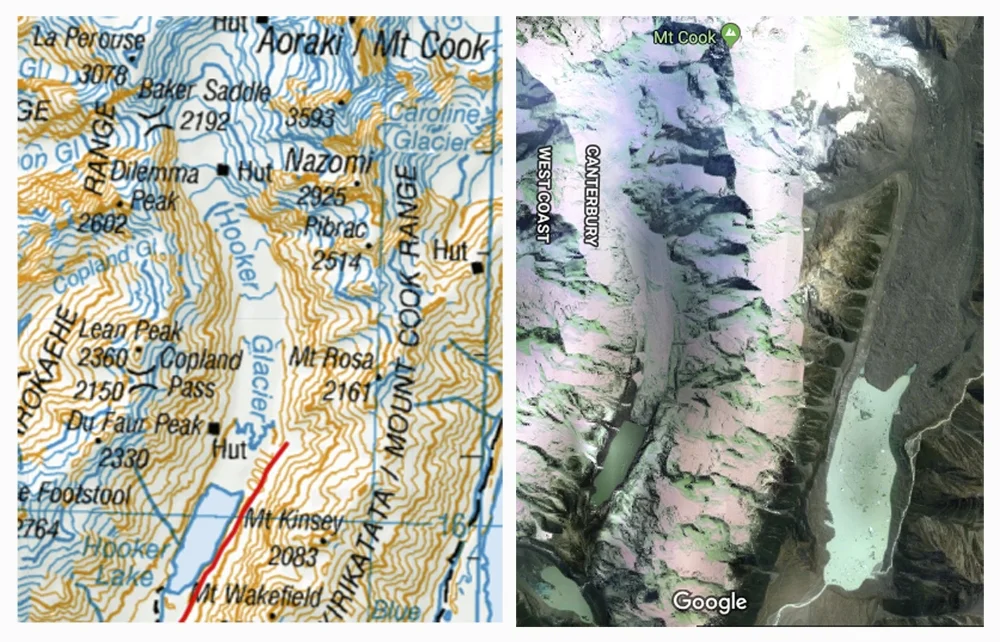The trail towards Namche from Lukla, is well worn.
At 2860m above sea level, Lukla is the main starting point for treks heading into Sagarmatha National Park, and is also the starting point for lesser traveled treks into the Makalu Barun National Park, which includes Meru Peak and Makalu. This part could also join to the main Everest trekking routes via the Island Peak trek at the end of the Chhukhung Valley, making a very long circuit for the those who have the time for more wandering.
After shunning the advances of eager porters, I found the track to my destination for the night - Phakding - and strode off with lofty confidence; my pack embracing me from behind as if to say “your’ve got this, girl”.
The walk from Lukla to Phakding, although very up and down, trends downward, finishing at an elevation some 200m lower than Lukla. The trail largely follows a milky aquamarine river (Dudh Kosi) through the valley floor and passes through quaint villages with tea houses and shops selling trekking provisions. Even though this was the end of the season, there was still an air of ‘business to be done’.
It was early in the day when I started walking.
Women were outside their homes engaged in the days tasks - washing clothes, preparing vegetables, washing children’s hair, tending to goats. The sky was a deep blue and occasionally I would catch a glimpse of a snow-clad peak. There was a noticeable absence of noise - just the sound of children laughing, the river flowing, birds singing …
Walking the trail into Phakding is akin to walking a main highway in New Zealand. The trails are the only way supplies can be delivered to villages higher up; everything travels by human or donkey power. Yaks are seen at higher elevations. I saw people carrying the most insane loads and also learned very quickly to stay to the mountain-side of the trail whenever a long line of donkeys came through - kicking up dust, with their ‘driver’ cracking the whip on foot behind, whistling and vocalising their instructions which only the donkeys could understand. Whilst the majority of supplies come in via the trail, helicopters are increasingly being used as well, particularly beyond Namche.
A man, singing away loudly to himself, carries a huge load down towards Lukla.
A heavily laden donkey seems to know the way to go.
The trail kept me engaged and acutely aware of my surroundings.
My senses felt as if they were on hyperdrive; I was over-whelmed by the colours, smells and sheer beauty of the trail. It was a humbling experience to know that before me, many incredible people had walked this same way - Sir Ed, Rob Hall, George Mallory … what a path to walk along. I am certain though, that Sir Ed did not have the luxury of using modern wire suspension bridges to negotiate river crossings! These bridges, suspended high above the rivers, look intimidating, but are such an integral part of successful transportation for the mountainous regions, that life without them would be far more arduous.
Suspension bridges always have Buddhist prayer flags on them, as a way of ensuring safe passage across the river.
It was hard to believe I had lost 200m in elevation, when I walked, tired, into Phakding village, less than three hours after leaving Lukla.
I felt as if I had been walking uphill since leaving Lukla, but the reality was:
Starting elevation: 9,383 ft / 2,860 m
Ending elevation: 8,563 ft / 2,610 m
Starting oxygen: 72% of sea level
Ending oxygen: 74% of sea level
Distance covered: 7.5 km
Time hiked: 2h 40m
In New Zealand, a 7.5 km walk is one that I would be able to easily and quickly do, in a short period of time, without breaking into too much of a sweat.
In Nepal, this same distance at a higher elevation, means everything slows right down. I was not feeling the reduction of oxygen in terms of my breathing, but my body was telling me there was less available for my muscles to use - I walked slowly considering I was going to a lower elevation. I was relieved to see the teahouse was still open that I had researched before leaving New Zealand - it was two years old and looked comfortable. I knew as I got higher into the mountains, that comfort would cease to be!
A new clean sleeping lodge is behind the main teahouse.
The ‘Sherpa Guide Lodge’
was clean, warm and cheap. I paid extra to have my own bathroom (NZ $12), but a room with no bathroom was only 400 rupee ($5 NZ). The shared bathroom facilities were clean and also had warm showers available. - a small luxury.
It is expected practice to eat at the teahouse you are staying in. The food at the Sherpa Guide Lodge was wonderful. My total spend here was NZ $20 including room, dinner, breakfast and lemon-ginger tea. This lodge also included free wifi and the room I stayed in had a power point, so the charging for me was free, otherwise it was 500 rupee an hour (standard charge for the mountain teahouses).
On my way out of Phakding to Namche, I stopped at Everest Lodge Restaurant and Bar for a very good coffee made by a friendly local, Chimmy, who spoke with a strong American accent. When I commented on it, he thanked me profusely - seemingly it is a desirable attribute!
He had never been to the USA.
Chimmy and I chatted for some time before I set off towards Monjo - the official start of Sagarmatha National Park. I had caffeine in my veins and had slept well. The day was clear and warm.
I was good to go.















































